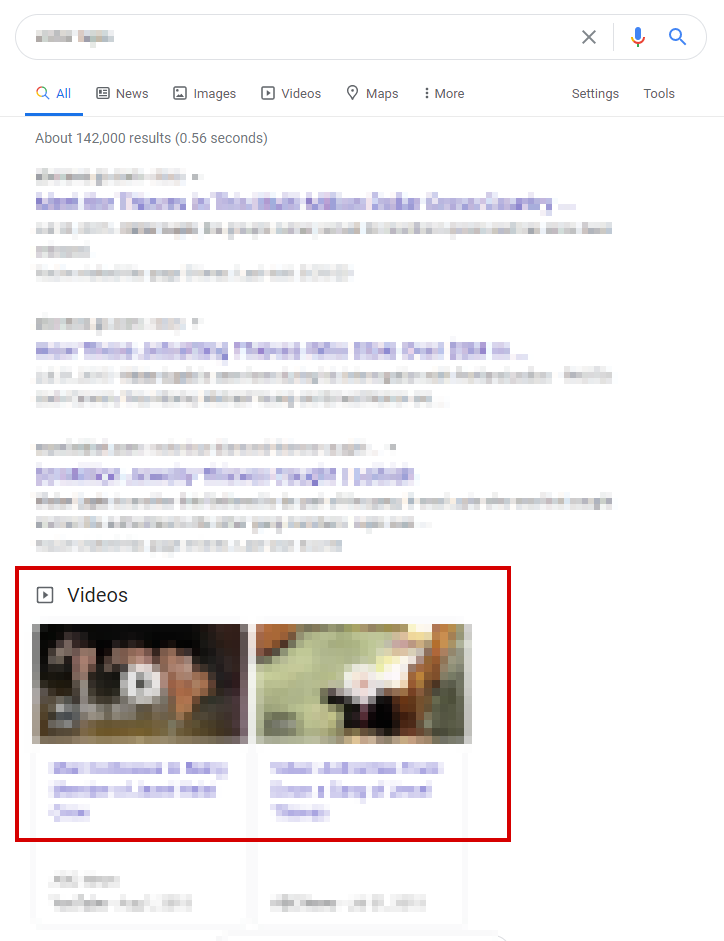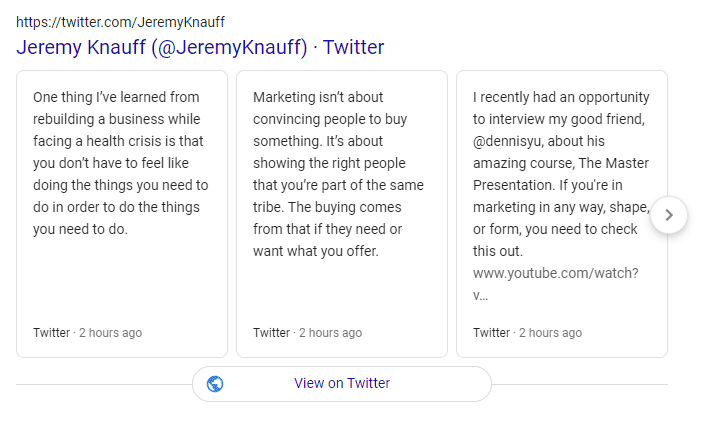27 Sep How to Take Over the SERPs for Your Name via @jeremyknauff
Have you ever had someone say something about you online that wasn’t true?
I think most of us have.
We all understand the importance of a personal brand.
It’s incredibly important to control how your personal brand is perceived online.
But there are many things that can hurt you in that regard.
Things that can pop up in the SERPs when someone searches for our name that we may not want there.
Other people with similar names, information inaccuracies, and even outright lies.
Information that might kill speaking or media opportunities or cause people to doubt your expertise.
Maybe even information that can encourage people to leave negative reviews about you or your business.
So it’s in our best interest to control what comes up on the first page – or even better, the first few pages of the search results.
But how do you do that?
Read on to find out.
Building the Assets
Domain / Website
If you don’t already own your name as a domain and have a website on it, you need to do something about that immediately.
This is the foundation of your online reputation management and will be your “digital headquarters.”
From your website, visitors will be able to learn more about you.
They can:
- Sign up for your email list.
- Find your social media profiles.
- Browse your content – articles, videos, images, etc.
But this won’t happen magically.
All of the SEO basics still apply here.
You can’t just have a hastily made website and expect it to rank well for your name.
Unless there is nothing else about you online.
You’ll generally face less competition than you would for other types of keywords, but you’ll still need to get the on-site factors right.
You need to create useful, original content, and be able to earn links to your website.
You can also republish content here that you’ve previously published elsewhere.
Be sure, though, you get the publisher’s permission and you properly use the rel=”canonical” attribute.
I know that Search Engine Journal allows this, but the people who run it obviously have an understanding of SEO that most publishers don’t.
My advice: When asking a publisher, try to make sure they understand how the tag works.
If they understand that it tells the search engines that they are the original publisher – and it will be beneficial to them – they’ll be more inclined to give you the green light to republish the content on your own website.
As this becomes a more authoritative asset, you can also use it to link out to other assets to help them rank higher.
Also, while you can spin up dozens of domains with various extensions and get them to rank for your name, you also have to consider how that might look.
Most would see that and think you’re trying to hide something.
If you’re trying to suppress negative content, this may be a last resort approach.
But for most, a single domain is ideal.
Images
Humans are visual creatures, so utilizing images can be a powerful way to control what the search results for your name are.
Depending on Google’s whims, these images could show up somewhere on the first page of the search results.
I’ve seen cases where they’re at the top, somewhere in the middle, or even at the bottom.


But no matter where they are, they typically draw the eye to them.
So it’s critical to make sure they convey the impression you want.
It’s also important to make sure they provide what the search engines are looking for.
First, they should be large, high-quality images, and named appropriately based on your name
Like this:
Jeremy-Knauff-speaking-BA-Q3-2020.jpg
The images don’t just have to be headshots.
They could also be just about anything else you can come up with like:
- Images with quotes from you.
- Book covers from books you’ve published.
- You speaking on stage or virtually.
Next, wherever we put them on our website, we use the appropriate alt attributes to help search engines understand what they are about.
<img src"..." alt="Jeremy Knauff, speaking at the Board of Advisors Q3 2020 meeting" >
In some cases, we can also set alt text when uploading our images to some social networks, as well.
If you have the ability to do that, you should.
Finally, we should point links to these images.
Particularly if they are on our own websites or other authoritative websites.
These links can come from websites that we own and other sources – but we’ll talk more about that later in the article.
Again, the key is to ensure they are high-quality, as large as possible, placed on pages in a way that helps search engines understand what they are about.
Videos
Following the same concept, we can use videos published on YouTube to secure additional positions in the search results for our name.


It’s important to include our name in the video title, description, and tags.
And, as with images, point links to these videos.
A good approach is to also embed these videos on your own website where relevant because that will help them to earn more views.
And if someone happens to stumble across your videos in the search results, more views create a stronger impression.
I also recommend properly implementing schema markup where you’ve embedded these videos to help search engines better understand what they are about
Social Media Profiles
It’s just common sense that you need to own your name on all of the major social networks.
But two, in particular, are especially useful because they tend to take up significantly more real estate on screen than others.
Those two are Twitter and YouTube.
We’ve already discussed the role video plays, so there’s no need to rehash that.
As for Twitter, if you’re active, Google will display your recent tweets directly in the search results.
This secures a significant portion of the screen, very close to the top of the page.


It’s important to properly use schema on your website as well as include links to your social profiles from your website to help search engines connect the dots.
Otherwise, they may not know which social profiles are yours.
Yoast has some capabilities for doing this, but you can also embed your own JSON for schema directly into your HTML.
It isn’t directly related to controlling the search results but critical in how your personal brand is perceived.
We also want to make sure your social profiles are consistently branded.
You should use the same headshot and cover photo on each platform.
They will vary slightly from platform to platform because each has different size and positioning requirements, but the general layout should be the same.
Podcasts
Google displays podcast episodes in the search results.
So, hosting your own and being a guest on other podcasts can be another powerful way to secure additional positions in the search results.


Google may not always display podcast results when someone searches for your name.
But the way I look at it, why leave an opportunity off the table?
Guest Posting / Columns
Part of controlling the search results depends on building a number of new digital assets.
But we can also leverage other pre-existing websites to control what people see when they search for your name.
Guest posts and/or columns can be powerful tools because we’re leveraging an existing website, where in most cases, the owner is consistently working to grow, too.
This means that as time goes on, its authority continues to grow – making it a more valuable asset.
The difference between a guest post and a column is simply a matter of volume.
A guest post would be a singular article while a column would be anything more than that.
The key is to make sure your content is listed under your name.
Rather than simply saying “guest author” or something like that.
Ideally, there should be an author page, where all of your articles are listed as you see here.
Since the vast majority of publishers will be using WordPress, this will probably already be in place.
Your articles should also include your bio.
Again, since most publishers use WordPress, this will probably already be there.
Where you can do so in a relevant way, you should include images and videos in these articles properly configured as we discussed earlier and even include your name in a natural way, if you can.
You might be thinking, “But Jeremy, how can I include my own name in my own articles without sounding odd?”
Well, I just showed you. 🙂
There are other benefits to using your own name in your articles, including helping readers feel more connected.
You Have the Assets, Now What?
Link Building
Building assets isn’t enough.
We also need to build links to all of these assets in order for them to rank for our name.
Fortunately, we generally won’t need as many links – nor will they need to be as authoritative – as when trying to rank for more competitive commercial terms.
We can acquire these links through a variety of methods.
Obviously, you can use any link building method you would normally use for traditional SEO.
But you can also use what many would consider riskier link building techniques.
Generally, you won’t face as intense competition compared to commercial terms and you’ll be flying under the radar when trying to rank digital assets for your own name.
This is especially true when dealing with social networks and other large websites.
They already have so many other links that any you build will likely go unnoticed even though they may have enough impact to affect ranking.
While it seems obvious to me, I’ll point out that you should use your name, and maybe a modifier of some sort here and there, as the anchor text when building these links.
Driving Traffic
Getting these assets in front of more people is important for multiple reasons.
The first and most obvious reason is that it puts your personal brand in front of more people in a positive light.
More awareness is always a good thing.
But an added – perhaps even more important benefit, is that increased awareness leads to an increased branded search for your name.
This is a good ranking signal with Google and it may help improve the ranking of your website overall.
And depending on the context, this may even encourage people to search for your name with modifiers, such as “Joe Smith interview” or “Mary Jones podcast.”
This has a positive effect on branded search, but it also helps to control what shows up in Google’s search suggestions.
You can drive traffic to these assets primarily through social media (both organic and paid) and through email.
On social media, you can post certain assets like articles or podcast episodes, organically.
Or you can run paid ads to put them in front of even more people.
You can do the same thing with email, by sending links out to your list.
But it’s important to do this in a way that creates value for your audience rather than just a sloppy link drop.
Otherwise, you’ll turn your audience off and undo all the hard work you’ve done.
More Resources:
- 7 Ways to Improve Your Brand Perception with Reputation Management
- 7 Expert Tips to Protect Your Online Reputation
- 5 Brand Protection Tactics That Work
Image Credits
All screenshots taken by author, September 2020
Sorry, the comment form is closed at this time.